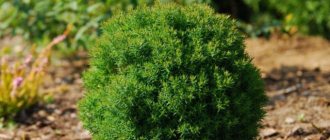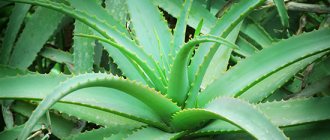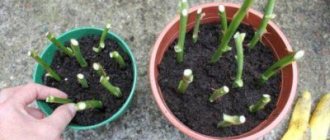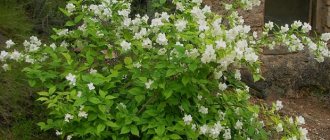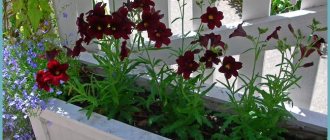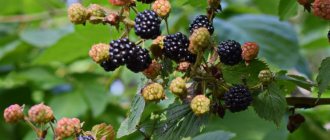Loading… The homeland of the evergreen beauty thuja is North America, whose climate, compared to ours, is warmer. However, thanks to breeders, today it can be grown even in harsh climatic zones, knowing some of the nuances. For example, thuja feels great in the Urals, planting and caring for which is generally not particularly difficult. The most important thing is to choose a zoned variety of thuja and plant it on time. And then all you have to do is support the development of the young beauty, providing her with moisture and nutrition.
Conditions for the growth of thujas in the Urals
The main parameter that is considered when deciding whether to purchase a particular tree is frost resistance. It is important for the gardener to know whether the plant can survive the winter safely. The Urals belong to winter hardiness zones 3–4 with minimum winter temperatures down to -34.5°C. This means that for planting you need to buy thujas, the labeling of which will necessarily indicate the third zone.
Did you know? Thuja is one of those conifers that benefit from pruning the top. If the tree is becoming too elongated and there are bare sections of the trunk, pruning will help redirect nutrients from growth to branch development.
If you purchase a variety for zone 5 (minimum temperature -29°C), then you will need to create a winter shelter for such a tree. And be sure to grow it in a place protected from the wind. Over time, it can acclimatize and in the future will not need special measures. But with equal probability he may die. The next parameter is humidity. Thujas are evergreen plants. This means that they do not go into a state of complete dormancy like deciduous ones, so they are watered regularly throughout the growing season.
In October - November, intensive watering is carried out to give the needles the opportunity to stock up on moisture. These rules will remain the same for any region.
Thujas can grow healthy and attractive in a sunny area or in partial shade. The presence of a completely sunny area is important only for varieties with decorative (golden, silver) needles. It will appear more clearly when grown in such an area. When planted in the shade, the needles will acquire a more pronounced green color.
Learn about the use, planting and care of Western Teddy Thuja.
Technology and step-by-step description of planting thuja in autumn
Coniferous plants can be planted both in spring and autumn. You should not delay planting in the fall, otherwise the tree may not take root. The area for the thuja should be protected from drafts and well lit in the morning. At noon, the tree should not be exposed to direct sunlight, otherwise the plant will not survive the winter well due to dehydration .
Ephedra loves nutritious turf soil with peat and sand. To plant a tree, you need to dig a hole, which must correspond to the root system of the seedling. The hole for planting is dug 15-30 cm deeper and 35-40 cm wider than the roots with an earthen lump of the plant. If trees are planted on the street along the alley, then the distance between them should be from 3.5 to 4 meters. Several bushes in the country can be planted at a distance of one to five meters.
Boarding procedure:
- The roots of the seedling are soaked in water until the air bubbles completely come out of the ground.
- The bottom of the planting hole is filled with a mixture of soil and humus, to which mineral fertilizers for conifers are added.
- The bush is placed in a hole, the roots are straightened and covered with nutritious soil mixture. It is necessary to ensure that the root collar is slightly above the surface of the earth.
- The soil is carefully compacted and watered abundantly.
- When the water is absorbed, the tree trunk circle is mulched with pine bark, compost, peat or wood chips. The lower branches and trunk should not be covered with mulch.
The tree trunk circle is covered with mulch so that when growing a tree in the Urals, Siberia or other areas with cold winters, the roots of the plant do not freeze. In summer, mulch will protect the root system from heat and help conserve moisture.
Variety selection
The genus Thuja consists of 5 species. On the territory of Russia, only one of them is widely represented - the western thuja (Thuja occidentalis), but if you wish, you can order other varieties if the nursery delivers to order. All varieties based on Thuja occidentalis can be grown in winter hardiness zones 2–7. This means they are suitable for the Ural climate.
The western thuja itself is a large tree with a height of over 40 m. But shorter varieties are used for garden design. Their height is 5–10 m.
Did you know? Thuja is a long-living plant. It can grow for almost 800 years.
Among these are:
- Variety Fastigiata , represented by a slender 15-meter tree with a narrow conical crown.
- Smaragd is the most popular columnar thuja. It also grows over 15 m. The diameter of the crown reaches 5 m. The needles of Smaragda are bright green in summer and do not lose their attractiveness in winter.
- If you don’t like a strictly pyramidal crown, choose Columna . This tree is in the shape of a truncated cone with an expanded top. This variety is chosen for its resemblance to cypress and the ability to give the surrounding landscape a Mediterranean style.
Gardeners who want to plant a tree of the same appearance, but smaller in size, can be advised to pay attention to other varieties.
Thuja in the Moscow region
In the Moscow region, as well as throughout central Russia, two types of thuja can be grown: western and folded.
The most popular varieties:
- Emerald. Easy to grow and absolutely undemanding variety. The color is bright green or yellow. Grows up to 4 m tall and 5 m wide. It develops in the form of a beautiful pyramid. An important feature is that it holds its shape well even without trimming.
- Brabant. Tall variety. Grows in the shape of a column. A sought-after variety due to its fast growth and affordable price. It practically does not change color throughout the year, it is quite picky about the composition of the soil - it prefers light, fertile soils.
Thuja foldata is the tallest type of thuja, but is prone to freezing:
- Zebrina is an unusual pyramid-shaped variety. It stands out with its original bright green coloring with white strokes. Used as a single plant.
- Kornik. Low grade. Characterized by a beautiful regular column shape. It tolerates haircuts well, but is quite demanding in care - it needs fertilizing, watering, and insulation.
Reproduction methods and their features in the Urals
Reproduction of thuja is possible in two ways:
- planting cuttings;
- seeds.
Read all about transplanting thuja from a pot into the ground.
The first of them is convenient for gardeners. If the cutting takes root successfully, the resulting plant will be identical to the one from which the branch was taken. For selection, the second method is used. Cuttings can be collected from late summer to late autumn. But we must remember that germination is a slow process, and it will take almost a year for the shoots to develop into seedlings. This planning allows you to grow enough seedlings to create a hedge.
To obtain seeds, female cones of one variety are pollinated with pollen from another. If pollination is successful, the cones will produce seeds that contain the characteristics of the two parent varieties. It will be a kind of thuja, different from both of them. If the seeds were naturally pollinated by pollen from the same tree, then the seeds should produce plants of the same variety. It will just take them a little longer to grow into a real tree.
Did you know? Thuja is considered a healing tree. It impregnates the air around with antimicrobial components - phytoncides.
Vegetative
Vegetative propagation is a type of propagation in which a new plant is formed from a part of the parent. In this case it is cuttings. Before you start planting, you need to prepare the planting material. To do this, you will need a branch 15–20 cm long. It must be completely healthy. The top should show signs of new season growth and the base should have strong woody bark. Branch diameter is 5–8 mm. Cut it at an angle of 45 degrees. The lower needles are removed. At the base of the future seedling, carefully pry up the bark. The cut site is treated with a growth stimulator in accordance with the instructions for the drug. “Kornevin”, “Epin”, “Athlete” are suitable.
Video: propagation and cultivation of thuja by cuttings
A week before planting the cuttings, prepare a pot with soil mixture. Use horticultural sand. But you can also take soil disinfected with Fitosporin solution (5 g of the drug per bucket of water). The product destroys phytopathogenic microflora that is found in the soil. This should be done a week before planting. They also practice watering the soil with boiling water in order to destroy the pest larvae that end up in the soil.
Did you know? In China, they believe that thuja branches, if brought indoors, can drive out evil spirits.
Planting a seedling itself is very simple:
- Make holes in the soil mixture with a pencil at a distance of at least 3 cm from each other and plant the cuttings there. The depth of the mounting hole is 15 mm. The tilt angle is 45 degrees.
- The soil around the seedling is compacted.
- Carry out abundant watering.
- Humidity must be constantly maintained at the same level. The top 3 cm of soil should be moistened.
- After 6 weeks, the seedling will have formed a root system. It will be ready to be transplanted into its own pot for further development.
- Such material can only be planted in the ground after a year.
Cuttings are not suitable for only one type of conifer - dwarf varieties, whose annual growth is 5 centimeters or less.
Generative
Reproduction by seeds or spores is called generative. To do this, planting material must be collected. Thuja cones ripen in September. They look like small yellow-brown boxes. You need about 8 of them.
We recommend that you find out which plants can and cannot be planted next to the thuja.
The collected cones are placed in a paper bag and left to ripen in a sunny place. This process lasts 2–3 days. The seeds are then shaken out of the seed pods (cones). They need a period of cold to germinate. This means that the gardener will need to prepare the peat moss and place it in a sealed plastic container. Seeds are placed on top of the moss in a layer. They need to be lightly pressed into the peat, covered with a lid and stored in the cold (0...+2°C) before planting in the spring.
With the onset of spring, the container is taken out. Prepare peat cups or tablets. The latter are a very convenient form for germinating seeds. The tablet is moistened with water and the seeds are pressed into the surface.
Important! Do not use manure when planting thuja. Even in a rotted state, it contains a lot of nitrogen, which will burn the roots and can cause the death of the seedling.
Then the prepared seed tablets are placed in a container and placed on a sunny windowsill or in a greenhouse.
After 2–3 weeks, the seeds will germinate to a height of 5–8 cm. But do not forget to keep the peat moist. After 2 weeks, the rooted seedlings are transplanted into pots for further development. Soil composition: drainage layer at the bottom of the pot and peat or other nutrient mixture on top. In such conditions, the seeds will grow throughout the year.
How to plant?
You can plant thuja either with cones, that is, with seeds, or with cuttings or seedlings. At the same time, we must remember that when sowing seeds, the varietal qualities of a particular thuja variety may not be preserved.
Planting is carried out in special planting holes. Their size should correspond to the earthen coma that is located on the roots of the thuja. The depth of the hole should be such that the root collar is level with the ground.
The distance between thujas directly depends on their height. So, if the height of the thuja does not exceed 10 meters, then the distance between them should be at least 5 meters. For those plants whose height is up to 6 meters, the distance should be at least two meters. If thujas are planted to create a hedge, then the distance between them should be up to 1 meter.
Landing
Planting of seedlings in open ground is planned for spring. To do this, you need to prepare the area. This should be an area with sufficient lighting - at least 6 hours of full sun daily. The soil must be drained. Its acidity does not matter, although thujas prefer slightly acidic soil.
Find out at what distance to plant thujas from each other.
Landing dates
Next spring it will be time to plant germinated young seedlings. Since the plant is still weak and tender, it can be planted in the soil when the air temperature warms up to +10°C. Before planting, be sure to harden the seedlings. To do this, take them out of the room and into the street every day for a week, increasing the time they stay there every day.
Preparing the site
The soil under the thuja should have good water permeability and be nutritious, so start by making sure its permeability. Dig a hole up to 60 cm deep, equal to the planting hole for an adult tree, and completely fill it with water. Wait until it drains and fill it a second time. If after 1–2 hours there is still water in the hole, then when planting you need to make a drainage layer.
Important! Yellow needles on a seedling
-
a sign that it is drying up and is almost dead.
Such material is rejected. The quality of the soil also matters. Heavy clay soils contain no more than 5% organic matter, so they are diluted with sand for looseness and garden soil or compost for nutrition. To plant a one-year-old seedling, you will need a bucket of compost.
Selection of seedlings
If there is a lot of planting material, but not all of it suits you, just select those seedlings that will be the tallest. Good planting material has bright green needles. It has a straight trunk without damage or traces of disease. When removed from the pot in which it grew, numerous and developed roots are found.
Step-by-step disembarkation
For planting in a permanent place of growth, planting pits are prepared. Their depth should be 2 times the root ball, and their width should be 2–3. It is advisable to make the hole square. This will cause the roots to grow downwards rather than bending in a circle as they would when growing in a pot.
Basic rules for caring for thuja
Before purchasing a new variety, it is important to check with the nursery what watering regime the young seedling requires. Adult plants become less demanding and easier to care for, but young plants may die if there is a lack of moisture. In the evenings and mornings, not only root watering is carried out, but also sprinkling, which is mandatory for a number of varieties. When spraying the needles, street dust, which settles on the rough needles in large quantities, is washed away. Stop watering by October, when sap flow stops until spring.
Modern techniques for caring for thujas at home suggest abandoning loosening in favor of mulching. Surface roots are easily damaged when loosened, but they also do not like weeds, so the trunk circles are sprinkled with pine needles, sawdust, and small pebbles.
Reproduction is possible by cuttings and seeds.
Thujas do not need feeding often. Usually in the spring a small amount of nitrogen-containing fertilizer is introduced to stimulate the growth of young shoots. In summer, you can add a small amount of potassium fertilizer. If you plant it in soil with nutrient compositions, then the next time fertilizing will be needed only in the third year.
Important! Excess fertilizer leads to long and abundant flowering, after which many cones are formed. This does not have the best effect on the decorative appearance of a tree or shrub, since nutrition is directed to the growth of seeds, and not needles.
Site selection and soil preparation
The best soil for thuja is peaty, fertile with a small amount of sand, breathable. Poverty is not an obstacle; annual feeding is enough.
Most varieties love bright light, but can withstand partial shade well. Before planting, dig up the soil, add clean sand to loosen it, and in the fall, before spring planting, add humus or compost.
How to plant thuja correctly
It is best to buy 3-year-old seedlings in containers from nurseries. This one does not need to be prepared; it can be planted immediately by simply transferring it into a pre-prepared hole. If the root system is open, then before planting the seedling is soaked for 6 hours in a solution of potassium permanganate, and then the same amount in a solution of a growth stimulator.
The planting hole is dug with reserve, since a drainage layer of pebbles, broken bricks, and expanded clay is poured onto its bottom. Depending on the variety, the distance between plants is maintained at 0.5-5 m. It is best to buy ready-made soil for backfilling, intended for Cypress, and add a little ash and sand into it at home.
Cover the roots so that the root collar, after compaction and watering, is flush with the soil level. It would not be superfluous to install a support to which the trunk is tied to avoid subsequent distortion.
Note! The tree trunk circle is generously mulched; peat, sawdust, and small wood chips can be used.
Shelter for the winter
To ensure that the young plant goes into dormancy mode and is not damaged during frost, do the following:
- From October, watering is completely stopped, fertilizers are not applied, and molding is not performed.
- The crown is covered with burlap or agro-canvas, and then tied with a cord. This measure will protect the branches from breaking under the weight of snow.
- The trunk is hilled and mulched.
- Remove the cover in the spring, when warm weather sets in.
Features of care
Thuja is low maintenance and very easy to care for. You don't have to waste a lot of time. In order to grow successfully, she will need:
| Month | Action |
| February | Sanitary and forming trimming. |
| March | Applying a shock dose of fertilizers. |
| April – September | Regular watering. |
| October | Intensive watering before wintering. |
| November | Preparing the tree for winter. |
Watering and fertilizing
The peculiarity of watering thuja is as follows: it tolerates wet soil well, but poorly tolerates waterlogged soil. Thuja is a very slow consumer of moisture, and if the water does not drain, the roots will always be wet, which will result in their rotting and death of the tree.
For newly planted bushes, watering is organized more often - every 2-3 days. Water is poured so as to wet the root zone. Then the frequency of irrigation is reduced to once every 5 days. A layer of 7cm of mulch will also help maintain more uniform soil moisture and temperature.
Preparing thuja for winter
In order for the plant to prepare for the dormant period, it is necessary to stop feeding and watering in the fall. Although some types of thuja tolerate minor winter cold well, it is better to cover young shrubs with spruce branches for the winter. To do this, the tree is hilled high, the trunk circle is sprinkled with a thick layer of peat, after which the plant is covered with spruce branches.
The area around mature trees must be sprinkled with mulch, and the plants themselves are not covered. However, it is recommended to tie the branches of the bushes with twine so that the snow that falls in winter does not break them.
During frosts, cracks may form , which should be covered with garden varnish in the spring. In the spring, the thuja is covered with non-woven material, which will protect the needles and branches from the strong spring sun.
Transplanting a mature tree
Coniferous plants have a shallow root system, so replanting them is quite easy. Transplant procedure:
- You need to step back 40-50 cm from the trunk and use a sharp shovel to prick the soil around the bush.
- Carefully pry up the tree along with the outlined circle and the trunk area.
- Remove the plant from the ground, place it on a wheelbarrow and transport it to a new planting site.
- Place the tree in a previously prepared hole along with a lump of earth, sprinkle with soil mixture and water generously.
Large trees pinned a year before transplanting. During this time, new roots will grow inside the circle and the soil will not fall apart when the plant is removed. In a new place, with proper care, transplanted thujas take root quickly.
Pests and diseases of thuja
When growing coniferous trees, problems may arise, which most often arise for the following reasons:
- attack by pathogens or pests;
- weakening after wintering;
- incorrectly chosen place for the tree;
- incorrect landing;
- errors in care.
Among the pests that are dangerous for thuja are leafrollers, aphids, thuja moths, spider mites, scale insects and bark-damaging leafrollers. To prevent plants from being affected by pests, it is recommended to spray trees with insecticides every spring for preventive purposes. This should be done twice with an interval of two weeks.
Bacterial and fungal infections appear as brown spots or yellowish needles. In order not to start the disease and not to destroy the plant, it is necessary to treat it twice with fungicidal preparations with an interval of 14 days.
Planting according to instructions and proper care will ensure the good growth of healthy trees. Since thuja is the most unpretentious coniferous plant, even a novice gardener can cope with its cultivation on his own plot.
Culture propagation
Cuttings
The most popular method of propagating thuja is cuttings. Growing from cuttings allows you to preserve the properties of the parent plant. Many summer residents who are engaged in breeding, planting and caring for thujas are wondering why it is necessary to take the tops of the axial shoots of the tree to collect cuttings? Experts explain that it is these branches that retain the branching pattern inherent to this species. If side branches are cut off, an irregular branching pattern will result.
The best period for taking cuttings from the parent tree is the spring month of April. At this time, the first stage of plant growth occurs. The tree from which cuttings are taken must be 2-3 years old and have scaly leaves.
Thuja
Attention! You can take cuttings in the summer, for example, in June, when the second period of its growth is recorded. Cuttings are cut from the heel
The area of separation from the parent tree must be treated with a disinfectant solution.
There are several ways to root cuttings. This could be a substrate, water or a container with moss. Cuttings taken in spring work best to produce a root system in the substrate. The substrate is a mixture of river sand and garden soil. To disinfect sand, a 3% solution of potassium permanganate is poured into it.
Is it possible to grow thuja from seeds?
Not only breeders, but also experienced gardeners and summer residents are familiar with the process of growing thuja from seeds. The growing process can last from 2 to 3 years. The main thing is patience and quality care. Only newly collected seeds are suitable for sowing, in late summer-early autumn. Beginners may be interested in the question, when is the best time to plant thuja seeds in open ground?
Experts advise sowing seeds in autumn in prepared boxes or flat, 15 cm deep, pots. The planted material is stored at home throughout the winter. Seeds sown in autumn produce stronger and healthier seedlings and grow earlier. These indicators are important for a young plant in its first years of life.
Is it possible to grow thuja from seeds?
Seeds can be planted in the soil in the spring, but stratification is recommended before planting. Seeds must go through the stage of preparation for planting in the ground through natural cooling. Experts recommend cooling the seeds in the refrigerator, in the part where vegetables are stored. When favorable weather arrives, the seeds need to be sown in the soil. This method of planting thuja seeds in spring gives germination rates of around 90%.
Tips for germinating seeds
Beginning gardeners and summer residents who decide to grow thuja from seeds for their plot need to familiarize themselves with the growing rules and recommendations of experts on how to plant thuja seeds correctly and how to care for them.
Here are some tips:
- Seeds are planted in prepared boxes.
- The soil for thuja should be a mixture consisting of 3 components: peat (2 parts), garden mixture (1 part), sand (less than 1 part).
- Seeds are placed in the furrows laid and sprinkled with soil, which must be compacted.
- Moderate watering is carried out so as not to expose the seeds.
- In spring, shoots appear.
- The box with seedlings is placed in partial shade so that young plants do not come under direct sunlight.
Problems with outdoor care
With excessive watering and high humidity, thuja can be affected by fungal diseases.
In the Urals, this evergreen plant can be affected by:
- fusarium,
- brown Schutte,
- cytosporosis
In the presence of these diseases, dark spots appear on the trunk and needles, and the shoots begin to dry out. In the fight against these diseases, copper-containing preparations and Bordeaux mixture are used. The plant must be treated once every two weeks.
Thuja is also very often attacked by pests such as scale insects and aphids. Affected plants stop growing, begin to turn yellow and wilt. To combat these pests, drugs such as Karbofos or Actellik are used.
